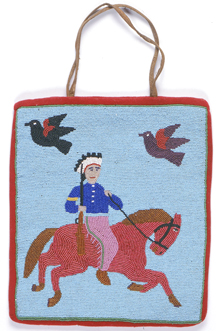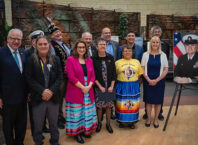{mosimage}
The new exhibition explores the unique position of the horse in historic and contemporary Native American culture. The exhibition “A Song for the Horse Nation” recently made its simultaneous debut at the Smithsonian’s National Museum of the American Indian in New York and on the museum’s website.
The exhibition celebrates the relationship between American Indians and horses, featuring 98 elaborate examples that include horse trappings, objects with horse motifs and new works specially commissioned for the show.
Originally indigenous to the Americas, the horse had become extinct before being reintroduced to the Western Hemisphere by way of European ships in the 15th century. The exhibition revolves around the return of what some Native people call the Horse Nation, a great ally to the Native nations.
“Even though the pinnacle of the horse lasted only a century, this exhibition details how Native people rapidly integrated the horse into their lifeways, quickly becoming among the best mounted soldiers in the world,” said National Museum of the American Indian Director Kevin Gover (Pawnee).
The online exhibition shares the script with the actual one, offering photos of many objects on display at the museum. Web viewers who live far away from the museums in Washington, D.C., and New York get a chance to share the experience in real time thanks to the online version’s simultaneous launch.
“It’s a comprehensive representation of the gallery exhibition that will grow in time to include additional educational resources and incorporate more interactive elements that might not be possible in the physical exhibition,” said Jason Wigfield, a web developer for the museum.
“It’s a good opportunity for people, who, geographically speaking, may not be able to make it to the museum. And in addition to that, it’s accessible anytime and for long after the exhibition closes.
“This online exhibition is a great resource for teachers, parents, and anyone interested in exploring this topic,” Wigfield said.
Interactive features, such as the opportunity to hear the word for “horse” in several Native languages through the computer, are a natural on the Web. Both the online exhibition and the one in New York provide recordings for the following languages: in Assiniboine, thongatch-shonga or sho-a-thin-ga (“big dog”); in A’aninin (Gros Ventre), it-shuma-shunga (“red dog”); in Lakota, Sunkakhan (“holy dog” or “mystery dog”); in Siksika of the Blackfoot, ponoka-mita (“elk dog”); in Cree, mistatim (“big dog”).
The exhibition uses video, images and commissioned artwork to carry the story of American Indians’ relationship with the horse into contemporary times.
“A Song for the Horse Nation” will be on view at the museum in New York until July 7, 2011. It is scheduled to reopen at the museum in Washington, D.C., in October 2011 and run through January 2013, followed by a national tour.
To visit the online exhibition go to the website: www.AmericanIndian.si.edu/ exhibitions/horsenation.







